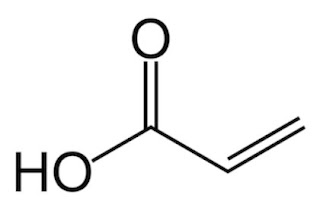Biobased acrylic acid
Type of post: Fact sheet.
Series: Biobased chemicals – Organic acids.
Publication date: 05/05/2021. Last update: 05/05/2021.
Description
- Organic acid with 3 carbon atoms.
- It is a clear, colourless, corrosive liquid with a characteristic acrid or tart smell.
- Other names: prop-2-enoic acid.
Applications
- Formation of homopolymers or copolymers which are used in the manufacture of various adhesives, coatings, diapers, detergents, paints, plastics and textiles. The main use of crude acrylic acid is the generation of acrylate esters, followed by the production of polyacrylic acid, used mostly in superabsorbent polymers.
- Chemical intermediate in multiple industrial processes.
Conventional petrochemical route
- Cracking of fossil naphtha to produce propylene / Oxidation of propylene.
Main biobased routes
- [3-HPA via] Fermentation of sugars to produce 3-hydroxypropionic acid (3-HPA) / Dehydration of 3-HPA.
- [Biobased naphtha via] Cracking of biobased naphtha to produce propylene / Oxidation of propylene.
- [Glycerol via] Dehydration of glycerol to acrolein / Oxidation of acrolein.
- [Lactic acid via] Fermentation of sugars to produce lactic acid / Dehydration of lactic acid.
Actors – Active projects
- ADM / LG Chem (1)
In 2019, ADM and LG Chem announced a joint development agreement to create biobased acrylic acid using ingredients from ADM corn processing.
- Axens / Cargill / IFPEN [Lactic acid via] (2,3)
In 2020, Procter & Gamble (P&G) granted Cargill an exclusive license that allows Cargill to develop and commercialize a technology that converts lactic acid into acrylic acid. At the end of that year, Cargill joined forces with Axens and IFPEN to further develop and scale the technology.
Actors – Suspended/idle projects
- Arkema [Glycerol via] (4,5)
In 2010, Arkema built a pilot plant in France (few kg per day) to convert biobased glycerol to acrylic acid. The process was developed to full-scale manufacturing readiness but put on hold as the high cost of glycerol.
- BASF / Cargill / Novozymes [3-HPA via] (4,5,6,7)
Novozymes and Cargill collaborated on renewable acrylic acid technology since 2008. Both companies worked to develop microorganisms that can efficiently convert renewable feedstock into 3-HPA. BASF joined the collaboration to develop the process for conversion of 3-HPA into acrylic acid in 2012. They demonstrated the production of 3-HPA at pilot scale in 2013 and also successfully converted 3-HPA to glacial acrylic acid and superabsorbent polymers in 2014. They were aiming to setup an integrated pilot plant (80,000 L fermentation vessels) by the end of 2014. BASF exited the partnership in 2015.
- Nippon Shokubai [Glycerol via] (5)
It developed catalysts that convert glycerin into acrylic acid. After reported success at the pilot scale, the further advancement and implementation of this route hinged on the availability and cost of glycerol.
- Novomer (4,8)
Novomer developed a route to produce glacial acrylic acid from plant-based and renewable feedstocks. The monomer is created via thermolysis of poly(3-hydroxypropionate).
- OPX Biotechnologies [3-HPA via] (4,9)
It developed a process using fermentation of sugar to 3-HPA followed by dehydration to make acrylic acid. It worked jointly with Dow Chemical to develop an industrial scale process. In 2015, Cargill acquired OPX Biotechnologies’ fermentation technology.
Market
- Global acrylic acid production in 2019: 8.3 Mtons (10). All acrylic acid capacity is based on the two-stage oxidation of propylene route.
- Global biobased acrylic acid production: Not commercial production. The current projects are still at early stages and are expected to take some years before commercialization.
References
(1) ADM news: “ADM Joins Forces with LG Chem to Develop Sustainable Technology for Superabsorbent Polymers Used in Diapers”, 25/09/2019.
(2) BioRefineries Blog post: “P&G grants Cargill an exclusive license to develop a biobased acrylic acid production technology”, 20/05/2020.
(3) BioRefineries Blog post: “Axens, Cargill and IFPEN join forces to scale biobased acrylic acid production technology”, 08/12/2020
(4) E4tech, RE-CORD and WUR (2015) “From the Sugar Platform to biofuels and biochemicals”. Final report for the European Commission, contract No. ENER/C2/423-2012/SI2.673791.
(5) Bonaire Le: “Bio-based Acrylic Acid: Considerations for Commercial Viability and Success”. Nexant, 2014.
(6) Novozymes news: “BASF, Cargill and Novozymes target commercial bio-based acrylic acid process”, 17/08/2012.
(7) Cargill news: “BASF, Cargill and Novozymes achieved another milestone in bio-based acrylic acid”, 15/09/2014.
(8) Novomer website.
(9) Cargill news: “Cargill acquires OPX Biotechnologies’ fermentation technology”, 28/04/2015. (10) ChemAnalyst – Global Acrylic Acid Market: 2020.




